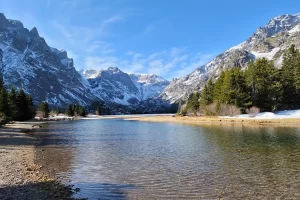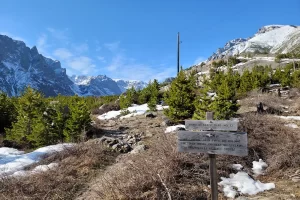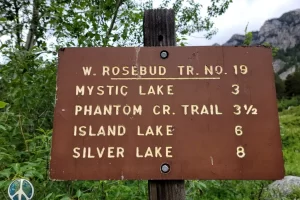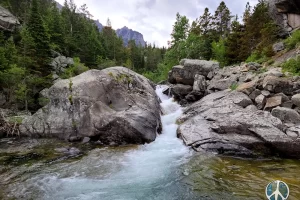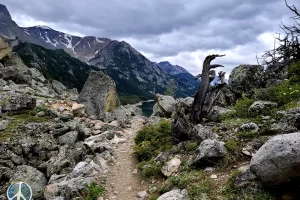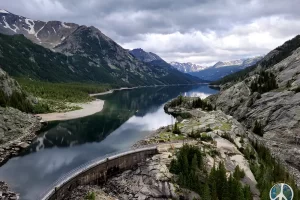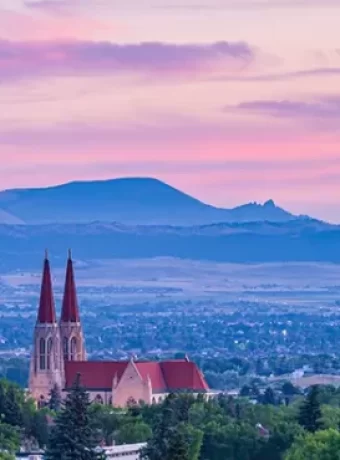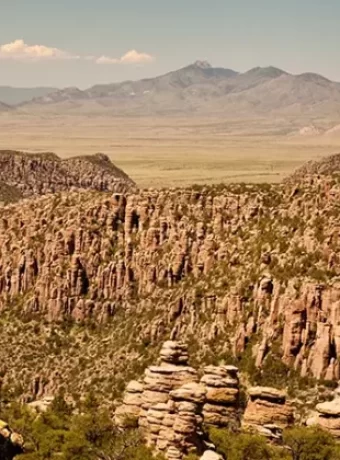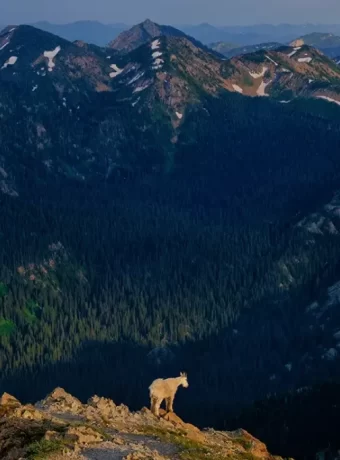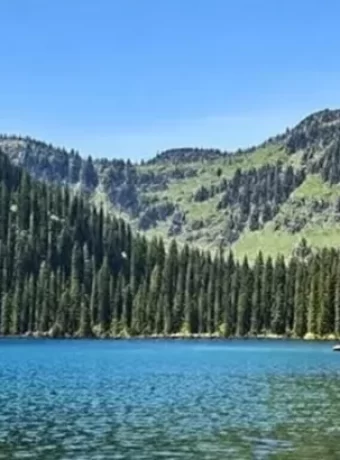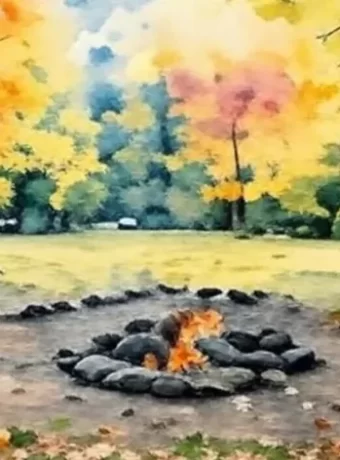Hiking Absaroka-Beartooth Wilderness: A Montana Experience
I want to tell you about a place that’ll steal your heart and leave you breathless. Yep, I’m talking about hiking in the Absaroka-Beartooth Wilderness. This rugged slice of Montana backcountry is a hiker’s dream come true. Absaroka-Beartooth Wilderness is part of the Greater Yellowstone Eco-system and home to grizzly bears.
With over 900,000 acres of untouched wilderness, the Absaroka-Beartooth Wilderness is a playground for adventure. Think soaring peaks, crystal-clear alpine lakes, and wildflower-strewn meadows that stretch as far as the eye can see. And the best part? You can explore it all on foot. So let’s go kick up some trail dust and catch a few Montana trout. As we hike and fly fish Montana.
Table of Contents
Exploring the Absaroka-Beartooth Wilderness
The Absaroka-Beartooth Wilderness is a vast, untamed expanse of rugged mountains, pristine forests, and crystal-clear alpine lakes. Spanning over 900,000 acres across southern Montana and northern Wyoming, this wilderness area is a true paradise for outdoor enthusiasts and nature lovers alike. As someone who’s spent countless days exploring the nooks and crannies of this incredible region, I can tell you firsthand that the Absaroka-Beartooth Wilderness offers an unparalleled hiking experience. From the towering peaks of the Beartooth Mountains to the lush valleys of the Absaroka Range, there’s no shortage of breathtaking scenery to discover.
Overview of the Region, Popular Hiking Areas, Planning Your Trip
One of the things that makes the Absaroka-Beartooth Wilderness so special is its sheer size and diversity. The Beartooth Mountains are known for their jagged, snow-capped peaks and high-altitude plateaus, while the Absaroka Range boasts gentler, more forested terrain. Some of the most popular hiking areas in the wilderness include the Beartooth Plateau, the Stillwater River Valley, and the East Rosebud Valley

Hiking, backpacking, fly fishing, Outdoor Apparel to fit every need. Graphic hoodies, leggings, gloves, designed and tested by outdoor enthusiasts.
These areas offer a wide range of trails suitable for hikers of all skill levels, from easy day hikes to strenuous multi-day backpacking trips. When planning your trip to the Absaroka-Beartooth Wilderness, there are a few key things to keep in mind:
- The hiking season is relatively short due to the high elevation and heavy snowfall. Most trails are only accessible from July through September.
- Be prepared for rapidly changing weather conditions, especially at higher elevations. Afternoon thunderstorms are common in the summer months.
- Bear country. Both black bears and grizzlies call this wilderness home. Carry bear spray and know how to use it.
- Many trailheads require a permit for overnight camping. Check with the local ranger station for details.
Before setting out on your adventure, be sure to study a wilderness map and familiarize yourself with the area. And remember, the Absaroka-Beartooth Wilderness is a true wilderness – cell phone service is spotty at best, and help can be far away. Come prepared, and always let someone know your plans.
Top Day Hikes in the Absaroka-Beartooth Wilderness
If you’re short on time or just looking for a taste of what the Absaroka-Beartooth Wilderness has to offer, day hikes are the way to go. Here are a few of my personal favorites:
- East Rosebud Lake & Creek, Absarokee-Beartooth Wilderness, Montana.
- Phantom Creek Trail 17, Absarokee-Beartooth Wilderness , Montana.
Lost Lake Trail
The Lost Lake Trail is a moderate 4.8-mile out-and-back hike that leads to a stunning alpine lake nestled beneath towering granite cliffs. The trail starts at the Clark’s Fork trailhead and climbs steadily through dense forest before opening up into a beautiful meadow. From there, it’s a short climb to the lake itself, where you can fish for trout or simply soak in the incredible views.
Elk Lake Trail
For a slightly longer day hike, check out the Elk Lake Trail. This 11-mile out-and-back trail follows the West Fork of Rock Creek through a lush valley before climbing up to Elk Lake, a serene alpine lake surrounded by wildflower-filled meadows. The trail can be a bit steep in places, but the views are more than worth the effort.
Pine Creek Trail
If you’re looking for a challenge, the Pine Creek Trail is a strenuous 10-mile out-and-back hike that climbs over 3,500 feet to Pine Creek Lake. The trail starts in a narrow canyon and follows Pine Creek past several waterfalls before emerging into a stunning cirque. The lake itself is a true gem, with crystal-clear water and towering peaks on all s
East Rosebud Trail
The East Rosebud Trail is a popular route that can be done as a long day hike or an overnight backpacking trip. The trail follows the East Rosebud Creek past a series of stunning alpine lakes, including Elk Lake, Rimrock Lake, and Rainbow Lake. The scenery is simply jaw-dropping, with rugged peaks, cascading waterfalls, and wildflower-filled meadows around every bend.
West Rosebud Trail
Last but not least, the West Rosebud Trail is a challenging but incredibly rewarding hike that climbs over 3,000 feet to Mystic Lake, a large reservoir surrounded by towering peaks. From there, hikers can continue on to Island Lake and the base of Granite Peak, the highest point in Montana. The views from the top are simply unbeatable. No matter which trail you choose, always come prepared with plenty of water, food, and appropriate gear. And remember to practice Leave No Trace principles to help keep this pristine wilderness wild for generations to come.
- West Rosebud Trail 19 to Mystic Lake and beyond.
- Cascading water on West Rosebud Creek Montana.
- Final Pass before decent to Mystic Lake Absarokee-Beartooth Wilderness
- First view full view of Mystic Lake as we descent in the valley.
The Beaten Path: A Classic Multi-Day Hike
For those looking for a true wilderness experience, the Beaten Path is a must-do. This classic 26-mile point-to-point hike traverses some of the most remote and stunning terrain in the Absaroka-Beartooth Wilderness, from the East Rosebud Valley to the Clarks Fork Valley. Most hikers take 3-4 days to complete the Beaten Path, camping at designated sites along the way. The trail passes through a variety of landscapes, from lush forests to high-altitude plateaus, and offers incredible views of the surrounding peaks and valleys. One of the highlights of the Beaten Path is the section along the East Rosebud Creek, where the trail passes by a series of stunning alpine lakes. Rimrock Lake, in particular, is a true gem, with crystal-clear water and a picturesque island in the center. Another highlight is the climb up to the Fossil Lake Cirque, a stunning amphitheater of jagged peaks and sparkling lakes. The view from the top is simply breathtaking, and well worth the effort of the climb. It’s important to note that the Beaten Path is a true wilderness trail, with no resupply points or amenities along the way. Hikers must carry all their own food, water, and gear, and be prepared for any weather conditions. A shuttle is also required, as the trail ends 26 miles plus from where it begins. But for those willing to put in the effort, the Beaten Path offers an unforgettable wilderness experience. There’s something truly special about immersing yourself in the backcountry for days on end, with nothing but the sound of your own footsteps and the wind in the trees. As someone who’s hiked the Beaten Path multiple times, I can attest to its incredible beauty and challenge. It’s a trail that stays with you long after you’ve returned to civilization, and one that I’d recommend to any experienced backpacker looking for a true adventure.
Hiking Absaroka-Beartooth Wilderness Tip:
Explore the Absaroka-Beartooth Wilderness for a true outdoor adventure. With diverse landscapes and breathtaking views, this area offers incredible day hikes like Lost Lake Trail or multi-day treks such as the Beaten Path. Prepare well, respect wildlife, and enjoy an unforgettable wilderness experience.
Exploring the Beartooth Plateau
If you’re looking for a true high alpine experience, the Beartooth Plateau is where it’s at. This vast expanse of tundra sits at a lofty elevation of 10,000 to 11,000 feet, making it one of the highest and most expansive plateaus in the United States. The plateau stretches for miles, offering endless opportunities for exploration. But be prepared – the air is thin up here, and even in mid-summer, temperatures can dip below freezing at night. One of the best ways to experience the Beartooth Plateau is by taking a scenic drive along the famous Beartooth Highway. This winding road climbs up from the town of Red Lodge, Montana, and crosses the plateau before descending into Yellowstone National Park. Along the way, you’ll be treated to some of the most spectacular views in the country. Picture vast expanses of wildflower-filled meadows, crystal-clear alpine lakes, and rugged peaks stretching as far as the eye can see.
Short Summer Season
One thing to keep in mind is that the Beartooth Plateau has a very short summer season. The highway typically opens in late May or early June, depending on snowfall, and closes again in mid-October. But trust me, it’s worth planning your trip around this narrow window. There’s nothing quite like experiencing the plateau in full bloom, with carpets of wildflowers stretching out before you.
High Altitude Adventure
If you’re feeling adventurous, there are plenty of opportunities for hiking and backpacking on the Beartooth Plateau. But be warned – the high altitude can take some getting used to. I remember my first time hiking up there, feeling like my lungs were on fire with every step. But the views from the top were more than worth it. Just be sure to come prepared with plenty of water, warm layers, and a good map. The weather can change quickly up here, and it’s easy to get turned around in the vast expanse of alpine.
Wildlife and Safety in the Absaroka-Beartooth Wilderness
One of the things that makes the Absaroka-Beartooth Wilderness so special is its incredible diversity of wildlife. From majestic elk and bighorn sheep to elusive wolverines and grizzly bears, this rugged landscape is home to an array of fascinating creatures.
Black Bears, Grizzly Bears, and Food Storage
One animal you’re likely to encounter in the Absaroka-Beartooth Wilderness is the black bear. These intelligent and curious creatures are drawn to the scent of food, which means it’s crucial to practice proper food storage techniques when camping or backpacking in bear country. I always recommend using a bear-resistant food canister or hanging your food at least 10 feet off the ground and 4 feet from any tree trunk or branch. Trust me, the last thing you want is a curious bear rummaging through your campsite in the middle of the night.
Fishing for Brook Trout
If you’re an angler, the Absaroka-Beartooth Wilderness is a true paradise. The crystal-clear streams and alpine lakes are home to an abundance of brook trout, a beautiful and feisty fish that’s a joy to catch on a fly rod. One of my favorite spots to fish is the West Fork of Rock Creek, a pristine stream that winds through a stunning valley surrounded by towering peaks. The brookies in this stream are known for their vibrant colors and eager appetite, making for an unforgettable day on the water
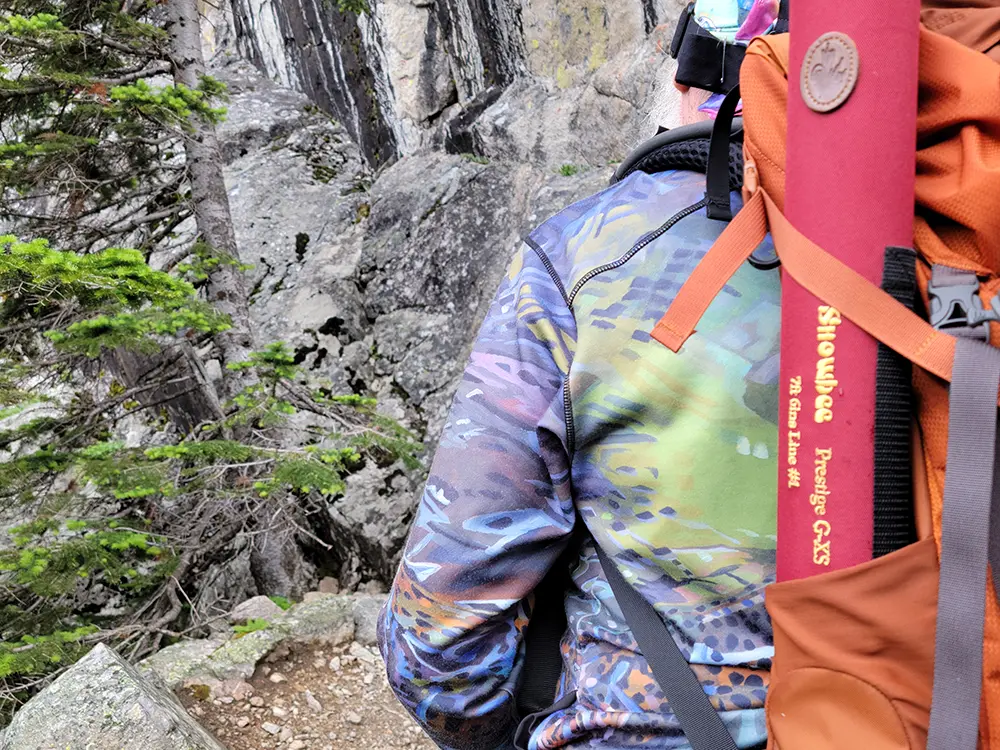
Hiking and backpacking I use two fly rods most of the time. I love the Prestige 1-weight for small rivers and creeks. For Lakes and rivers in and the wilderness area. A Prestige 11′ 3-weight fly rod for working the lakes edges and euro-nymphing Montana’s rivers.
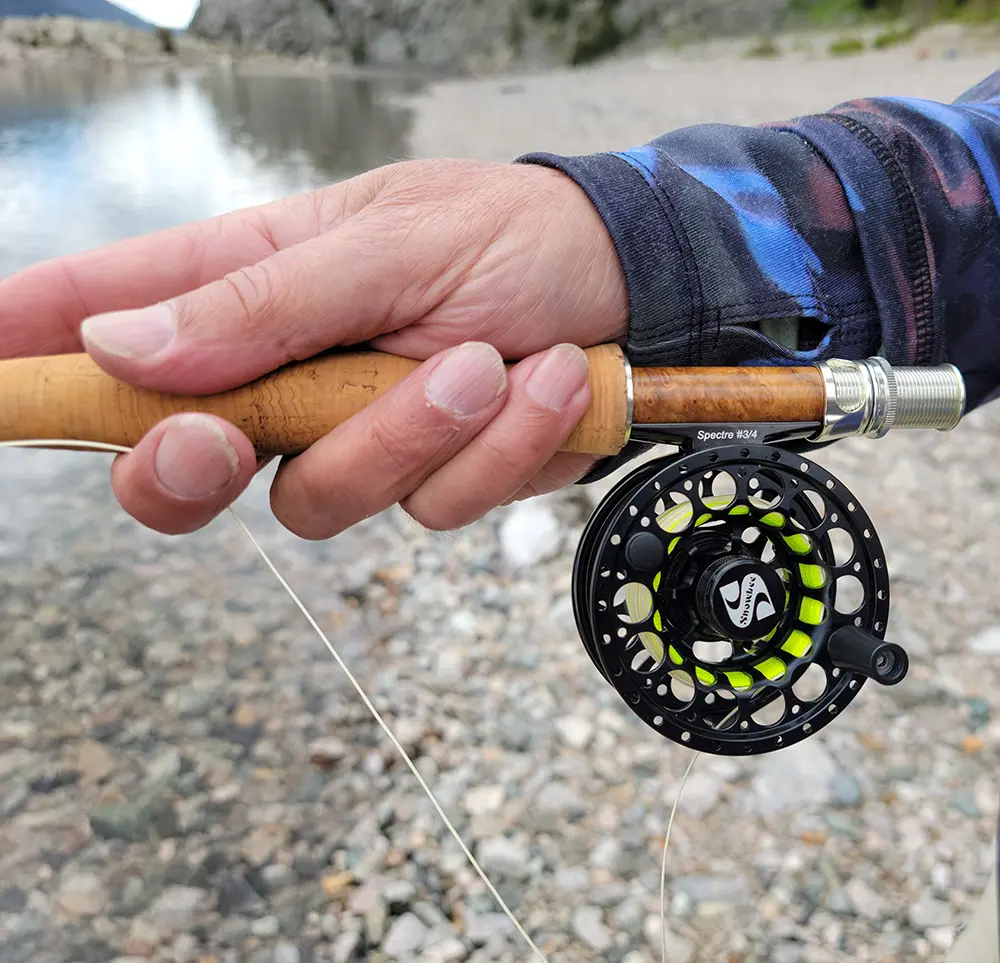
Base Camps and Gateway Towns
When it comes to exploring the Absaroka-Beartooth Wilderness, there are a few key gateway towns and base camps that serve as excellent jumping-off points.
Red Lodge, Montana
On the northern edge of the wilderness, the charming town of Red Lodge serves as a popular base camp for hikers, climbers, and outdoor enthusiasts. This historic mining town has a vibrant main street lined with shops, restaurants, and galleries, making it a great place to relax and resupply before heading into the backcountry.
Cooke City and Silver Gate, Montana
To the south, the tiny towns of Cooke City and Silver Gate sit just outside the Northeast Entrance to Yellowstone National Park. These remote outposts are surrounded by the rugged peaks of the Beartooth Mountains, offering unparalleled access to some of the most spectacular hiking and backpacking in the region. I’ve spent countless nights camping under the stars in the nearby Clarks Fork Valley, listening to the howls of wolves echoing off the cliffs. It’s an experience that never fails to leave me in awe of the raw beauty and power of this incredible landscape.
Yellowstone National Park
Of course, no trip to the Absaroka-Beartooth Wilderness would be complete without a visit to the crown jewel of America’s national park system: Yellowstone. This iconic park sits just to the south of the wilderness, offering a wealth of opportunities for wildlife viewing, geyser gazing, and backcountry exploration. Some of my favorite memories in the park involve hiking through the remote and rugged Lamar Valley, known for its thriving wolf population and stunning vistas of the surrounding peaks. It’s a place that truly embodies the wild spirit of the American West.
Absaroka-Beartooth Wilderness Tip:
Explore the Beartooth Plateau for a true high alpine experience. The short summer season offers wildflower-filled meadows and crystal-clear lakes. But prepare for thin air and freezing nights.
Red Lodge, Cooke City, and Silver Gate are great base camps to start your adventure in this rugged wilderness teeming with wildlife like elk, wolverines, and grizzly bears.
If you’re into fishing or hiking at high altitudes, don’t miss the West Fork of Rock Creek for brook trout or scenic drives on Beartooth Highway leading into Yellowstone National Park.
Tips for Hiking in the Absaroka-Beartooth Wilderness
When it comes to hiking trails in the Absaroka-Beartooth Wilderness, preparation is key. This vast, pristine wilderness area offers some of the most spectacular hiking opportunities in Montana, but it’s not without its challenges. As someone who’s spent countless days exploring the rugged terrain of the Beartooths, I’ve learned a thing or two about what it takes to have a safe and enjoyable hiking experience in this incredible wilderness. First and foremost, always check the weather forecast before heading out. The weather in the mountains can change rapidly, and afternoon thunderstorms are common in the summer months. Trust me, you don’t want to be caught above treeline when a storm rolls in. It’s also crucial to carry a map and compass and know how to use them. While many of the trails in the Absaroka-Beartooth Wilderness are well-marked, others can be faint or nonexistent. A good topo map and solid navigation skills can be a lifesaver if you get turned around. Another essential item to pack is bear spray. The Absaroka-Beartooth Wilderness is prime grizzly bear country, and encounters with these majestic creatures are not uncommon. Hiking in groups, making noise, and carrying bear spray can greatly reduce your chances of a negative encounter. When it comes to gear, layers are your friend. Even in the middle of summer, temperatures can drop quickly at high elevations. I always pack a warm hat, gloves, and a puffy jacket, even if it’s hot at the trailhead. And don’t forget about the bugs. Mosquitoes can be relentless in the Beartooths, especially near lakes and streams. A good bug spray or head net can make all the difference between a miserable slog and an enjoyable hike. Finally, remember to practice Leave No Trace principles when hiking in the Absaroka-Beartooth Wilderness. This means packing out all your trash, camping at least 200 feet from lakes and streams, and minimizing your impact on the fragile alpine environment. By following these tips and being prepared, you’ll be well on your way to having an unforgettable hiking experience in one of the most beautiful wilderness areas in the country. The Absaroka-Beartooth Wilderness is a true gem, and with a little know-how and respect for the land, it will continue to be enjoyed by hikers for generations to come.
Know Before You Go
Before setting out on any hike in the Absaroka-Beartooth Wilderness, it’s important to do your research and know what you’re getting into. The U.S. Forest Service is a great resource for information on trail conditions, closures, and any special regulations you need to be aware of. I always recommend checking recent trip reports from other hikers before heading out. These can give you a good idea of what to expect in terms of snow levels, stream crossings, and overall trail conditions. It’s also a good idea to let someone know your hiking plans before heading into the backcountry. Leave a detailed itinerary with a trusted friend or family member, including your planned route, expected return time, and any emergency contact information. And don’t forget to check the regulations for the specific area you’ll be hiking in. Some parts of the Absaroka-Beartooth Wilderness require a permit for overnight camping, while others have specific rules around campfires and food storage. By doing your due diligence and being prepared, you’ll set yourself up for a safe and enjoyable hiking experience in this incredible wilderness area.
Hiking Trails for All Skill Levels
One of the things I love most about hiking in the Absaroka-Beartooth Wilderness is the sheer variety of trails available. Whether you’re a seasoned backpacker or a first-time hiker, there’s a trail out there for you. For those just starting out, the East Rosebud Trail is a great option. This moderate hike follows the East Rosebud Creek through a stunning canyon, passing by waterfalls and alpine lakes along the way. The trail is well-maintained and easy to follow, making it a great choice for families or those new to hiking in the mountains. If you’re looking for more of a challenge, the Beaten Path is a classic backpacking route that traverses some of the most scenic parts of the Beartooth Mountains. This 26-mile trail takes you through high alpine meadows, past crystal-clear lakes, and over steep mountain passes. It’s not for the faint of heart, but the views are well worth the effort. For day hikers, the Mystic Lake Trail is a must-do. This 10-mile round trip hike takes you through dense forest and along the shores of West Rosebud Lake before climbing up to the stunning Mystic Lake. The trail is steep in places, but the reward at the end is more than worth it. No matter what your skill level, there’s a hiking trail in the Absaroka-Beartooth Wilderness that’s perfect for you. So lace up your boots, grab your pack, and get ready to explore one of the most beautiful places on earth.
Absaroka-Beartooth Wilderness Tip:
Preparation is key for hiking in Absaroka-Beartooth Wilderness. Check the weather, carry a map and compass, pack bear spray, dress in layers, use bug spray, practice Leave No Trace principles. Research trail conditions before heading out to ensure a safe hike.
FAQs in Relation to Hiking Absaroka-Beartooth Wilderness
Are there grizzly bears in the Absaroka mountains?
Yes, grizzlies roam the Absaroka Mountains. Hikers should carry bear spray and know food storage rules.
Are there bears in the Beartooth Mountains?
Both black and grizzly bears live in the Beartooth Mountains. Always stay alert and store food properly.
Can you hike Beartooth mountain?
You can hike trails around Beartooth Mountain, but be prepared for high altitudes and challenging terrain.
How big is the Absaroka-Beartooth Wilderness?
The Absaroka-Beartooth Wilderness spans about 944,000 acres of rugged Montana wilderness area with diverse hiking trails.
Conclusion of Hiking Absaroka-Beartooth Wilderness
Hiking Absaroka-Beartooth Wilderness is an experience you won’t soon forget. From the jaw-dropping vistas to the serene alpine lakes, every step on these trails is a revelation.
But more than that, immersing yourself in this untamed wilderness has a way of putting things into perspective. Out here, the daily grind fades away, and you’re reminded of what really matters.
So lace up those hiking boots, grab your sense of adventure, and head for the Absaroka-Beartooth. Trust me, this Montana wilderness will leave an imprint on your soul that’ll keep you coming back for more.
Fly Fish Montana, Pick a Destination
Montana has a lifetime of fly fishing or it’s just the beginning as you travel to Canada, Alaska, and onto Iceland. Or just fly fish Montana.

